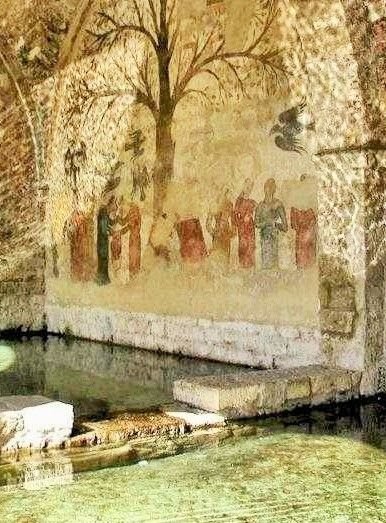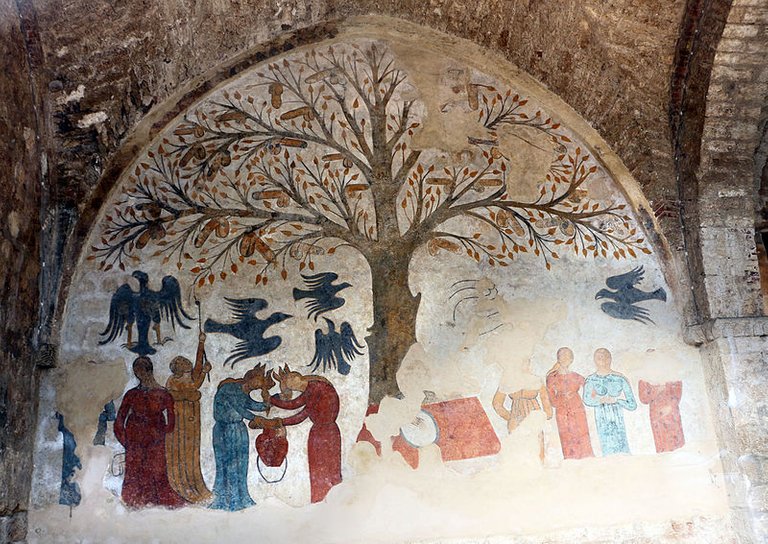As the name suggests, The Fertility Tree bears male organs as fruits. Dozens of them. Under the tree, eight women are busy gathering the exotic fruits, two of them seemingly engaged in a fight over a phallus. Funny as this may seem, the question that has left many historians baffled is what does this painting mean?
The Tree of Fecundity (L'Albero della Fecondita) was discovered in 1999 during restoration works on the Fountains of Abundance (Fonti dell'Abbondanza) in the Medieval city of Massa Maritima, in the Italian region of Tuscany. Experts believe the naughty mural was painted sometime between 1225 and 1338, a time when Massa Maritima was an independent city republic.
The discovery has left resident a bit embarassed and many support the most decent explanation possible under the ciscumstances, saying the mural is a political manifesto, having to do with the rivalry between the main political forces of the time – the Ghibelline party associated with the Holy Roman Emperor and the Guelph party, which supported the Pope.
However, others believe it is"the earliest depiction in art of women acting as witches".
In a book dedicated to the Fertility Tree mural, George Ferzoco, director of the Center for Tuscan studies at Leicester University, argues that the painting is obviously related to the folk tales of that period. At that time it was believed that witches would randomly castrate males, keeping their genitals in a box, as pets, even feeding them oats. In other stories, the witches stored their prey in nests in the trees.

According to one tale, a poor man deprived of his manhood somehow convinced a witch to give it back to him. The hag told him to climb up the tree and pick a penis from the nest. Naturally, the guy chose the biggest one, but the witch told him he could not have that one as it belonged to the parish priest.
The witch hunter's handbook
You might want to stop smiling at this point, as this particular story does not come from a joke book, but from one of the vilest tomes ever written, the Malleus Maleficarum (The Witches Hammer), the Inquisition's textbook for the identification and prosecution of witches. Described as the most sinister demonology book ever, Malleus Maleficarum was written by the Dominican iniquisitor Heinrich Kramer and published in 1487. By 1669, it had been reprinted 30 times, which gives us an idea of its popularity.
"All witchcraft comes from carnal lust, which in women is insatiable", Kramer wrote.
Contemporary scholars have little trouble identifying the misogyny and anxieties about female sexual desire, that are rife in the book, while the penis-snatching is nothing but an expression of the age-old castration fears.
"Many of the crimes (maleficia) attributed to witches concerned sexuality: copulation with incubus devils, procuring abortions, causing sterility and stillbirth, and impeding sexual relations between husbands and wives", writes folklorist Moira Smith.
Burned at the stake
The publishing of the book coincides with the first witch trials in Europe, personally approved by the Pope. Historians consider the decades between 1580 and 1650 as the peak period of the European witch trials. Estimates of the number of victims vary wildly, but most historians agree that between 40.000 and 100.000 women were executed as witches, most of them burned alive. Some 12.000 are documented in public records. None mention missing body parts recovered during the inquests.
As for the Fertility Tree mural, it has become a major tourist attraction, although people say that during restoration works, some of the offensive fruits have been whitewashed.
Thanks for reading


Wouldn't it be great to know the true story behind this mural? Maybe the artist didn't get paid, and decided he'd give the community a mural they'd never forget. Or maybe it was vandalized by miscreants after it was painted.
It reminds me of the dirty little doodles the medieval monks would put into the margins of their hand-copied Bibles.
I like the idea of the painter taking revenge. :)
img credz: pixabay.com
Nice, you got a 5.0% @minnowbooster upgoat, thanks to @ladyrebecca
Want a boost? Minnowbooster's got your back!
Good read.....Nice to know about the tree of fertility....Keep up the great content...